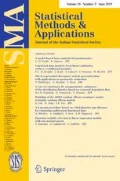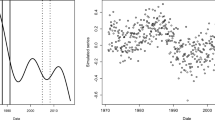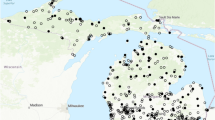Abstract
Long-term temporal trends in water temperature in rivers and streams are typically estimated under the assumption of evenly-spaced space-time measurements. However, sampling times and dates associated with historical water temperature datasets and some sampling designs may be haphazard. As a result, trends in temperature may be confounded with trends in time or space of sampling which, in turn, may yield biased trend estimators and thus unreliable conclusions. We address this concern using multilevel (hierarchical) linear models, where time effects are allowed to vary randomly by day and date effects by year. We evaluate the proposed approach by Monte Carlo simulations with imbalance, sparse data and confounding by trend in time and date of sampling. Simulation results indicate unbiased trend estimators while results from a case study of temperature data from the Illinois River, USA conform to river thermal assumptions. We also propose a new nonparametric bootstrap inference on multilevel models that allows for a relatively flexible and distribution-free quantification of uncertainties. The proposed multilevel modeling approach may be elaborated to accommodate nonlinearities within days and years when sampling times or dates typically span temperature extremes.
Similar content being viewed by others
Notes
Full name: The U.S. Army Corps of Engineers’ Upper Mississippi River Restoration (UMRR) Program Long Term Resource Monitoring (LTRM) element.
Calculated using mean daily discharge at Kingston Mines, Illinois (http://waterdata.usgs.gov/il/nwis/dv?referred_module=sw&site_no=05568500).
Temperature data may be obtained at http://www.umesc.usgs.gov/data_library/water_quality/water_quality_data_page.html.
Mean discharges for 1994–2002 and 2004–2010 were 358, 204, 783, 235, 416, 233, 522, 215, 172, and 204, 108, 276, 383, 496, 258 and \(478\, \hbox {m}^3/\hbox {s}\), respectively.
References
Araujo HA, Cooper AB, Hassan MA, Venditti J (2012) Estimating suspended sediment concentrations in areas with limited hydrological data using a mixed-effects model. Hydrol Process 26(24):3678–3688
Bühlmann P, Kalisch M, Meier L (2014) High-dimensional statistics with a view toward applications in biology. Ann Rev Stat Its Appl 1:258–278
Burgmer T, Hillebrand H, Pfenninger M (2007) Effects of climate-driven temperature changes on the diversity of freshwater macroinvertebrates. Oecologia 151:93–103
Bustillo V, Moatar F, Ducharne A, Thiéry D, Poirel A (2014) A multimodel comparison for assessing water temperatures under changing climate conditions via the equilibrium temperature concept: case study of the Middle Loire River, France. Hydrol Process 28(3):1507–1524
Caissie D (2006) The thermal regime of rivers: a review. Freshw Biol 51(8):1389–1406
Clark JS, Bell DM, Kwit MK, Powell A, Zhu K (2013) Dynamic inverse prediction and sensitivity analysis with high-dimensional responses: application to climate-change vulnerability of biodiversity. J Agric Biol Environ Stat 18(3):376–404
Demidenko E (2004) Mixed models: theory and applications. Wiley, Hobooken
El-Shaarawi A, Teugels J (2007) Environmental statistics: current and future. Int Stat Rev 73(2):233–236
Grant PJ (1977) Water temperatures of the Ngaruroro River at three stations. J Hydrol 16(2):148–157
Gray BR (2012) Variance components estimation for continuous and discrete data, with emphasis on cross-classified sampling designs. In: Gitzen RA, Millspaugh JJ, Cooper AB, Licht DS (eds) Design and analysis of long-term ecological monitoring studies. Cambridge University Press, New York, pp 200–227
Hockey JB, Owens IF, Tapper NJ (1982) Empirical and theoretical models to isolate the effect of discharge on summer water temperatures in the Hurunui River. J Hydrol 21(1):1–12
Hox JJ (2010) Multilevel analysis: techniques and applications, 2nd edn. Routledge, New York
Isaak DJ, Luce CH, Rieman BE, Nagel DE, Peterson EE, Horan DL, Parkes S, Chandler GL (2010) Effects of climate change and wildfire on stream temperatures and salmonid thermal habitat in a mountain river network. Ecol Appl 20(5):1350–1371
James W, Barko J (2004) Diffusive fluxes and equilibrium processes in relation to phosphorus dynamics in the Upper Mississippi River. River Res Appl 20:473–484
Johnson BL, Hagerty KH (2008) Status and trends of selected resources of the Upper Mississippi River System. US Geological Survey, Report LTRMP 2008-T002
Kasurak A, Kelly R, Brenning A (2009) Mixed-effects regression for snow distribution modeling in the Central Yukon. The 66th Eastern Snow Conference, Niagara-on-the-Lake, Ontario, Canada
Lewis J (2006) Fixed and mixed-effects models for multi-watershed experiments. In: Proceedings of the 3rd federal interagency hydrologic modeling conference, 2–6 April 2006, Reno NV
Lyons J, Zorn T, Stewart J, Seelbach P, Wehrly K, Wang L (2009) Defining and characterizing coolwater stream fish assemblages in Michigan and Wisconsin. N Am J Fish Manag 29(4):1130–1151
Lyubchich V, Gel YR, El-Shaarawi A (2013) On detecting non-monotonic trends in environmental time series: a fusion of local regression and bootstrap. Environmetrics 24(4):209–226
Lyubchich V, Gray BR, Gel YR (2015) Multilevel random slope approach and nonparametric inference for river temperature, under haphazard sampling. In: Lakshmanan V, Gilleland E, McGovern A, Tingley M (eds) Machine learning and data mining approaches to climate science. Springer, Cham, pp 137–145
McNamee R (2003) Confounding and confounders. Occup Environ Med 60(3):227–234
Meentemeyer RK, Haas SE, Václavík T (2012) Landscape epidemiology of emerging infectious diseases in natural and human-altered ecosystems. Ann Rev Phytopathol 50:379–402
Mohammadpour R, Shaharuddin S, Chang CK, Zakaria NA, Ghani AA, Chan NW (2014) Prediction of water quality index in constructed wetlands using support vector machine. Environ Sci Pollut Res 22:1614–7499
Mohseni O, Stefan HG, Erickson TR (1998) A nonlinear regression model for weekly stream temperatures. Water Resour Res 34(10):2685–2692
Mohseni O, Stefan HG, Eaton JG (2003) Global warming and potential changes in fish habitat in US streams. Clim Change 59(3):389–409
Morris JS (2002) The BLUPs are not “best” when it comes to bootstrapping. Stat Probab 56:425–430
O’Donnell D, Rushworth A, Bowman A, Scott E, Hallard M (2014) Flexible regression models over river networks. J R Stat Soc Ser C Appl Stat 63(1):47–63
Orr HG, Des Clers S, Simpson GL, Hughes M, Battarbee RW, Cooper L, Dunbar MJ, Evans R, Hannaford J, Hannah DM et al (2010) Changing water temperatures: a surface water archive for England and Wales. In: Kirby C (ed) International symposium on the role of hydrology in managing consequences of a changing global environment. British Hydrological Society, Newcastle, pp 1–8
Paul WL (2011) A causal modelling approach to spatial and temporal confounding in environmental impact studies. Environmetrics 22(5):626–638
Pilgrim JM, Fang X, Stefan HG (1998) Stream temperature correlations with air temperatures in Minnesota: implications for climate warming. J Am Water Resour Assoc 34(5):1109–1121
Preud’homme EB, Stefan HG (1992) Errors related to random stream temperature data collection in Upper Mississippi River watershed. J Am Water Resour Assoc 28(6):1077–1082
Regier H, Holmes J, Pauly D (1990) Influence of temperature changes on aquatic ecosystems: an interpretation of empirical data. Trans Am Fish Soc 119:374–389
Schertz TL, Alexander RB, Ohe DJ (1991) The computer program estimate trend (ESTREND), a system for the detection of trends in water-quality data. US Geological Survey, Water-Resources Investigations Report 91-4040
Shang J, Cavanaugh JE (2008) An assumption for the development of bootstrap variants of the Akaike information criterion in mixed models. Stat Probab Lett 78(12):1422–1429
Sheppard L (2003) Insights on bias and information in group-level studies. Biostatistics 4(2):265–278
Snijders TAB, Bosker RJ (2012) Multilevel analysis: an introduction to basic and advanced multilevel modeling, 2nd edn. Sage, London
Soballe DM, Fischer JR (2004) Long term resource monitoring program procedures: water quality monitoring. US Geological Survey, Techn Rep LTRMP 2004-T002-1
Stefan HG, Preud’homme EB (1993) Stream temperature estimation from air temperature. J Am Water Resour Assoc 29(1):27–45
van der Leeden R, Meijer E, Busing FMTA (2008) Resampling multilevel models. In: de Leeuw J, Meijer E (eds) Handbook of multilevel analysis. Springer, New York, pp 401–433
Ver Hoef JM, Peterson EE (2010) A moving average approach for spatial statistical models of stream networks. J Am Stat Assoc 105(489):6–18
van Vliet MTH, Ludwig F, Zwolsman JJG, Weedon GP, Kabat P (2011) Global river temperatures and sensitivity to atmospheric warming and changes in river flow. Water Resour Res 47, article id W02544. doi:10.1029/2010WR009198
Wakefield J (2003) Sensitivity analyses for ecological regression. Biometrics 59(1):9–17
Wang L, Akritas MG, Van Keilegom I (2008) An ANOVA-type nonparametric diagnostic test for heteroscedastic regression models. J Nonparametr Stat 20(5):365–382
Webb BW, Nobilis F (1997) Long-term perspective on the nature of the air-water temperature relationship: a case study. Hydrol Process 11(2):137–147
Webb BW, Clack PD, Walling DE (2003) Water-air temperature relationships in a Devon river system and the role of flow. Hydrol Process 17(15):3069–3084
Wood S (2006) Generalized additive models: an introduction with R, 2nd edn. Chapman and Hall/CRC Press, Boca Raton
Xia R, Demissie M (1999) Hydraulic analyses for LaGrange Pool of the Illinois River: a component of the restoration of large river ecosystems project. Watershed Science Section, Illinois State Water Survey, Contract Report 651
Acknowledgments
This study was partly funded by the U.S. Army Corps of Engineers’ Upper Mississippi River Restoration Program Long Term Resource Monitoring element. The research of Yulia R. Gel was supported in part by the Natural Sciences and Engineering Research Council of Canada. We thank Bruce Webb for helpful discussions.
Author information
Authors and Affiliations
Corresponding author
Electronic supplementary material
Below is the link to the electronic supplementary material.
Rights and permissions
About this article
Cite this article
Gray, B.R., Lyubchich, V., Gel, Y.R. et al. Estimation of river and stream temperature trends under haphazard sampling. Stat Methods Appl 25, 89–105 (2016). https://doi.org/10.1007/s10260-015-0334-7
Accepted:
Published:
Issue Date:
DOI: https://doi.org/10.1007/s10260-015-0334-7




